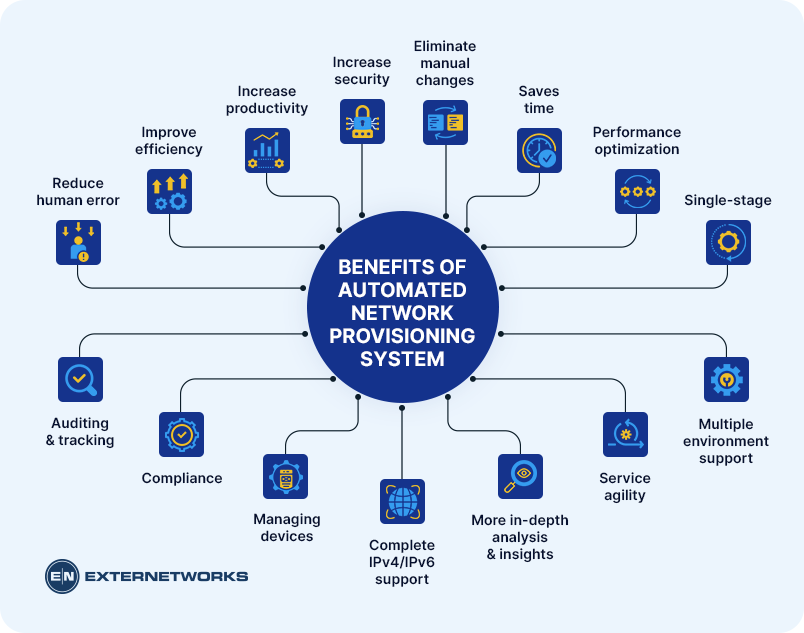Provisioning refers to the process of setting up the necessary IT infrastructure and can be used to describe the steps involved in managing access to data and other resources.
Network provisioning includes setting up a network for access by users, servers, containers, IoT devices, etc. Today, in our connected world, there are various types of items that consume networks.
Automated provisioning enables network managers to spend less time creating and managing policies, assigning IP addresses, and configuring IP-enabled devices. Automation can also help reduce errors that slow down your network’s performance. Automated provisioning processes can often be performed by just one person instead of a whole team.
Automation has become an increasingly important part of IT. It can have significant implications for network provisioning, particularly when it comes to improving performance. Usually, this will be seen by reducing the time needed to complete certain tasks.
Network automation can help improve your IT infrastructure’s ability for scalability, even as it performs complex analysis based on inputs received from the various devices available in your network. It allows for rapid deployment of new services, devices, and applications based on existing and reusable processes.
Automated network management implemented through technology allows for repeating or predictable tasks to be performed automatically according to policy. Network administrators shouldn’t need to assign IP addresses and perform other tasks any longer, as they can be automated. It speeds up the process significantly while also cutting down on the possibility of making any mistakes. You should still monitor your network.
Automation can help reduce the number of people required to oversee the network, potentially leading to cost savings.
A cloud-based provisioning and control platform automates the entire provisioning process, including IP address assignment, DHCP, and DNS configuration. Each step in the deployment process is carried out automatically by the system in a dynamic fashion as new services are deployed or devices are added or removed from the network. Policies can be defined to set parameters for how a system carries out certain tasks.
Here are some specific benefits of automating the network provisioning process.

The use of automation reduces the chance of human error during the provisioning process. For example, if you don’t know how to configure a device, you won’t accidentally change its IP address. If you’re not familiar with the proper way to add a host to a domain, you’ll never accidentally create duplicate hosts.
The use of automation improves the efficiency of the provisioning process. Instead of manually entering information into multiple screens, you can simply select the appropriate option. This makes the process more efficient.
When you automate the provisioning process, you can free up resources to focus on other projects. As long as the system is configured correctly, it will continue to work without intervention.
When you automate the provisioning of network components, you eliminate the opportunity for errors. The system will ensure that all necessary steps have been completed before allowing the component to function properly.
If you want to update a particular setting, you must go back to each screen where the setting was changed and update it there. With an automated system, you can just click one button to apply the desired change.
As a result of the dramatic reduction in the time needed to assign IP addresses and subnets, staff can now focus on performing higher-value tasks instead, freeing them up to perform more important tasks.
Significant drops in network outages and service degradation due to addressing errors and configuration errors. Network professionals who consider human factors responsible for at least some network outages are twice as likely to report them as infrequent or worse than those who don’t consider human factors to be responsible.
Full integration with DHCP/DNS provisioning enables administrators to dynamically obtain, configure, deploy and track critical networking resources from a single control panel.
Complete tracking and an audit trail for all provisioning activity, giving you full visibility into who made which changes and when. Furthermore, granular permission controls allow you to adjust permissions down to the level of details required by any object in the platform, such as an individual user or group.
It helps ensure full compliance with industry regulations and IT security requirements. A recent survey found that nearly 80 per cent of network professionals would like continuous verification and automated compliance reports as part of their current network solution.
A discovery and customer service mapping of every network-attached, Internet Protocol (IP)-enabled device.
Native support for both IPv4 and IPv6, allowing for dynamic IPv4 addressing and dual-stack with IPv6. An effective automated network provisioning system handles everything from subnet allocation to advanced field validation in network provisioning – including overlapping/dupe legacy environments.
Network optimization is based on an accurate view of the entire network and policy-based configuration. This is in contrast with the ad hoc operational decisions made by a fragmented view of the current network.
Faster service rollouts and faster times to market for new, added services as a result of increased staff productivity and streamlined provisioning processes.
The ability to manage multiple environments simultaneously, including both physical and virtual networks.
Automating network provisioning requires a lot of planning and preparation, but once you have a solid plan in place, there are several ways to go about automating network provisioning. You could start small and build up gradually, or you could jump right in and automate everything at once. Either way, you will want to consider the following factors before making this important decision:
If you’re looking to get started with automated network provisioning, we recommend starting with these basic steps:
As you work through each step, you can also look at some of our recommended solutions from ExterNetworks.
